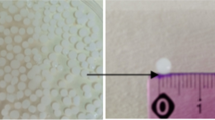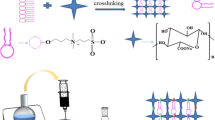Abstract
To investigate the potential use of Lentinus edodes (L. edodes) residue for Cd2+ adsorption, poly alcohol Na alginate (PVA) was applied to immobilize it. The parameters including contact time, pH, adsorbent dosages, and coexisting metal ions were studied. The suitable pH for immobilized L. edodes was 4–7 wider than that for raw L. edodes (pH 6–7). In the presence of Pb2+ concentration varying from 0 to 30 mg·L−1, the Cd2+ adsorption ratios declined by 6.71% and 47.45% for immobilized and raw L. edodes, respectively. While, with the coexisting ion Cu2+ concentration varied from 0 to 30 mg·L−1, the Cd2+ adsorption ratios declined by 12.97% and 50.56% for immobilized and raw L. edodes, respectively. The Cd2+ adsorption isotherms in single-metal and dual-metal solutions were analyzed by using Langmuir, Freundlich, and Dubinin-Radushkevich models. The Cd2+ adsorption capacities (q m) in single-metal solution were 6.448 mg·L−1 and 2.832 mg·L−1 for immobilized and raw L. edodes, respectively. The q m of immobilized L. edodes were 1.850 mg Cd·g−1 in Cd2+ + Pb2+ solution and 3.961 mg Cd·g−1 in Cd2+ + Cu2+ solution, respectively. The Cd2+ adsorption processes subjected to both adsorbents follow pseudo-second-order model. Mechanism study showed the functional group of L. edodes was -OH, -NH, -CO, and PVA played an important role in metal adsorbing. Mining wastewater treatment test showed that PVA-SA-immobilized L. edodes was effective in mixed pollutant treatment even for wastewater containing metal ions in very low concentration.
Similar content being viewed by others
References
Üçer A, Uyanik A Ş F, Aygün Ş F. Adsorption of Cu(II), Cd(II), Zn(II), Mn(II) and Fe(III) ions by tannic acid immobilised activated carbon. Separation and Purification Technology, 2006, 47(3): 113–118
Netzer A, Hughes D E. Adsorption of copper, lead and cobalt by activated carbon. Water Research, 1984, 18(8): 927–933
Karabulut S, Karabakan A, Denizli A, Yurum Y Y. Batch removal of copper(II) and zinc(II) from aqueous solutions with low-rank Turkish coals. Separation and Purification Technology, 2000, 18(3): 177–184
Brown P A, Gill S A, Allen S J. Metal removal from wastewater using peat. Water Research, 2000, 34(16): 3907–3916
Kandah MI. Zinc and cadmium adsorption on low-grade phosphate. Separation and Purification Technology, 2004, 35(1): 61–70
Sternberg S P, Claussen K. Lead and nickel removal using Microspora and Lemna minor. Bioresource Technology, 2003, 89(1): 41–48
Bailey S E, Olin T J, Bricha R M, Adrian D D. A review of potentially low-cost sorbents for heavy metals. Water Research, 1999, 33(11): 2469–2479
Romero-González M E, Williams C J, Gardiner P H E, Gurman S J, Habesh S. Spectroscopic studies of the biosorption of gold(III) by dealginated seaweed waste. Environmental Science & Technology, 2003, 37(18): 4163–4169
Xu J M, Zhang P. Development of immobilized cells technology in the treatment of water containing heavy metals. Environmental Science and Management, 2005, 30(6): 84–85 (in Chinese)
Schiewer S, Balaria A. Biosorption of Pb2+ by original and protonated citrus peels: equilibrium, kinetics, and mechanism. Chemical Engineering Journal, 2009, 146(2): 211–219
Aker S T, Gorgulu A, Anilan B, Kaynak Z, Aker T. Investigation of the biosorption characteristics of lead(II) ions onto Symphoricarpus albus: batch and dynamic flow studies. Journal of Hazardous Materials, 2009, 165(1/2/3): 126–133
Manning B A, Goldberg S. Adsorption and stability of arsenic(III) at the clay mineral-water interface. Environmental Science & Technology, 1997, 31(7): 2005–2011
Ahluwalia S S, Goyal D. Microbial and plant derived biomass for removal of heavy metals from wastewater. Bioresource Technology, 2007, 98(12): 2243–2257
Arica M Y, Bayramoglu G. Cr(VI) biosorption from aqueous solutions using raw and immobilized biomass of Lentinus sajorcaju: preparation and kinetic characterization. Colloids and Surfaces A: Physicochemical and Engineering Aspects, 2005, 253(1–3): 203–211
Baldrian P. Interactions of heavy metals with white-rot fungi. Enzyme and Microbial Technology, 2003, 32(1): 78–91
Wang J L. Bio-immobilized technology and water pollution control. Beijing: Science Press, 2002
Mallick N. Biotechnological potential of immobilized algae for wastewater N, P and metal removal: a review. Biometals, 2002, 15(4): 377–390
de-Bashan L E, Bashan Y. Immobilized microalgae for removing pollutants: review of practical aspects. Bioresource Technology, 2010, 101(6): 1611–1627
Sheng P X, Kin W H, Ting Y P, Chen J P. Biosorption of copper by immobilized marine algal biomass. Chemical Engineering Journal, 2008, 136(2–3): 156–163
Khoo K M, Ting Y P. Biosorption of gold by immobilized fungal biomass. Biochemical Engineering Journal, 2001, 8(1): 51–59
Robinson P K, Reeve J O, Goulding K H. Kinetics of phosphorus of phosphorus uptake by immobilized Chlorella. Biotechnology Letters, 1988, 10(1): 17–20
Iqbal M, Edyveane R G J. Biosorption of lead, copper and zinc ions on loofa sponge immobilized biomass of Phanerochaete chrysosporium. Minerals Engineering, 2004, 17(2): 217–223
Bayramoğlu G, Bektaş S, Arica M Y. Biosorption of heavy metal ions on immobilized white-rot fungus Trametes versicolor. Journal of Hazardous Materials, 2003, 101(3): 285–300
Wilkinson S C, Goulding K H, Robinson P K. Mercury accumulation and volatilization in immobilized algal cell systems. Biotechnology Letters, 1989, 11(12): 861–864
Gabriel J J, Baldrian P, Hladíková K, Háková M. Copper sorption by native and modified pellets of wood-rotting basidiomycetes. Letters in Applied Microbiology, 2001, 32(3): 194–198
Pan X L, Wang J L, Zhang D Y. Biosorption of Pb(II) by Pleurotus ostreatus immobilized in calcium alginate gel. Process Biochemistry (Barking, London, England), 2005, 40(8): 2799–2803
Wang J H, Tong Z F, Zeng A G. The application of immobilized cell in synthesis of adenosine triphosphate. Bioresource Technology, 2004, 31(3): 141–145 (in Chinese)
Chen G Q, Zeng G M, Tang L, Du C, Jiang X Y, Huang G H, Liu H L, Shen G L. Cadmium removal from simulated wastewater to biomass byproduct of Lentinus edodes. Bioresource Technology, 2008, 99(15): 7034–7040
Galli E, di Mario F, Lorenzoni P, Rapanà P, Angelini R. Copper biosorption by Auricularia polytricha. Letters in Applied Microbiology, 2003, 37(2): 133–137
Kappoor A, Viraraghavan T. Fungal biosorption an alternative treatment option for heavy metal bearing wastewaters: a review. Bioresource Technology, 1995, 53(3): 195–206
Liang S, Guo X Y, Feng N C, Tian Q H. Adsorption of Cu2+ and Cd2+ from aqueous solution by mercapto-acetic acid modified orange peel. Colloids and Surfaces. B, Biointerfaces, 2009, 73(1): 10–14
Zhang D, Gao J W, Ma P. Effect of competitive interference on the metal ions biosorption by Auricularia polytricha mycelial. Ecology & Environment, 2008, 17(6): 1822–1827 (in Chinese)
Luna A S, Costa A L H, da Costa A C, Henriques C A. Competitive biosorption of cadmium(II) and zinc(II) ions from binary systems by Sargassum filipendula. Bioresource Technology, 2010, 101(14): 5104–5111
Şengil I A, Özacar M. Competitive biosorption of Pb2+, Cu2+ and Zn2+ ions from aqueous solutions onto valonia tannin resin. Journal of Hazardous Materials, 2009, 166(2–3): 1488–1494
Özacar M, Şengil A, Türkmenler H. Equilibrium and kinetic data, and adsorption mechanism for adsorption of lead onto valonia tannin resin. Chemical Engineering Journal, 2008, 143(1–3): 32–42
Arıca M Y, Kaçar Y, Genç Ö. Entrapment of white-rot fungus Trametes versicolor in Ca-alginate beads: preparation and biosorption kinetic analysis for cadmium removal from an aqueous solution. Bioresource Technology, 2001, 80(2): 121–129
Aksu Z. Equilibrium and kinetic modelling of cadmium (II) biosorption by C. bulgaris in a batch system: effect of temperature. Separation and Purification Technology, 2001, 21(3): 285–294
Kargi F, Cikla S. Biosorption of zinc(II) ions onto powdered waste sludge (PWS): kinetics and isotherms. Enzyme and Microbial Technology, 2006, 38(5): 705–710
Padmavathy V, Dhingra S C. Kinetics of biosorption of cadmium on Baker’s yeast. Bioresource Technology, 2003, 89(3): 281–287
Wang X S, Hu H Q, Wang J, Sun C. The equilibrium and dynamics of Cu2+ biosorption by Na-type mordenite. Science and Technology Review, 2006, 24(11): 31–36 (in Chinese)
El-Naas M H, Al-Rub F A, Marzouqi A. Effect of competitive interference on the biosorption of lead(II) by Chlorella vulgaris. Chemical Engineering and Processing: Process intensification, 2007, 46(12): 1391–1399
Guo P, Gao H L, Chen P J. The rule of the adsorption to Cd2+ by immobilized bacteria. Journal of Jilin University, 2007, 37(2): 375–379 (in Chinese)
Ferraz A L, Teixeira J A. The use of flocculating brewer’s yeast for Cr(III) and Pb(II) removal from residual wastewaters. Bioprocess Engineering, 1999, 21(5): 431–437
Chen G Q, Zeng G M, Tang L, Du C Y, Jiang X Y, Huang G H, Liu H L, Shen G L. Bioaccumulation of chromium from tannery wastewater: an approach for chrome recovery and reuse. Bioresource Technology, 2008, 99(15): 7034–7040
Anayurt T R A, Sari A, Yuzen M. Equilibrium, thermodynamic and kinetic studies on biosorption of Pb(II) and Cd(II) from aqueous solution by macrofungus (Lactarius scrobiculatus) biomass. Chemical Engineering Journal, 2009, 151(1–3): 255–261
Jia R, Pei M J, Shi Y, Huang R D, Xiao Y Z. Studies on adsorption of Cu2+ by the fungus Aspergillus sp. China Environmental Science, 2003, 23(3): 263–266 (in Chinese)
Israilides C, Kletsas D, Arapoglou D, Philippoussis A, Pratsinis H, Ebringerová A, Hríbalová V, Harding S E. In vitro cytostatic and immunomodulatory properties of the medicinal mushroom Lentinula edodes. Phytomedicine, 2008, 15(6–7): 512–519
Kellner R, Mermet JM, Otto M, Widner HM. Analytical Chemistry. New York: Wiley-Vch, 1998, 824
Akar T, Tunali S, Kiran I. Botrytics cinera as a new fungal biosorbent for removal of Pb(II) from aqueous solutions. Biochemical Engineering Journal, 2005, 25(3): 227–235
Akar T, Tunali S. Biosorption performance of Botrytis cinerea fungal products for removal of Cd (II) and Cu(II) ions from aqueous solutions. Minerals Engineering, 2005, 18(11): 1099–1109
Şanli O, Ay N, Işiklan N. Release characteristics of diclofenac sodium from poly (vinyl alcohol)/sodium alginate and poly(vinyl alcohol)-grafted-poly(acrylamide)/sodium alginate blend beads. European Journal of Pharmarnaceutics, 2007, 65(2): 204–214
Zhang Y, Kogelnig D, Morgenbesser C, Stojanovic A, Jirsa F, Lichtscheidl-Schultz I, Krachler R, Li Y, Keppler B K. Preparation and characterization of immobilized [A336][MTBA] in PVAalginate gel beads as novel solid-phase extractants for an efficient recovery of Hg (II) from aqueous solutions. Journal of Hazardous Materials, 2011, 196: 201–209
Peng D B, Tian Y P. Isolation and composition analysis of a kind of extracts of antioxidant activity from Lentinus edodes. Food Research Development, 2008, 29(6): 89–63 (in Chinese)
Author information
Authors and Affiliations
Corresponding author
Rights and permissions
About this article
Cite this article
Ma, P., Zhang, D. Immobilized Lentinus edodes residue as absorbent for the enhancement of cadmium adsorption performance. Front. Environ. Sci. Eng. 6, 498–508 (2012). https://doi.org/10.1007/s11783-012-0429-4
Received:
Accepted:
Published:
Issue Date:
DOI: https://doi.org/10.1007/s11783-012-0429-4




